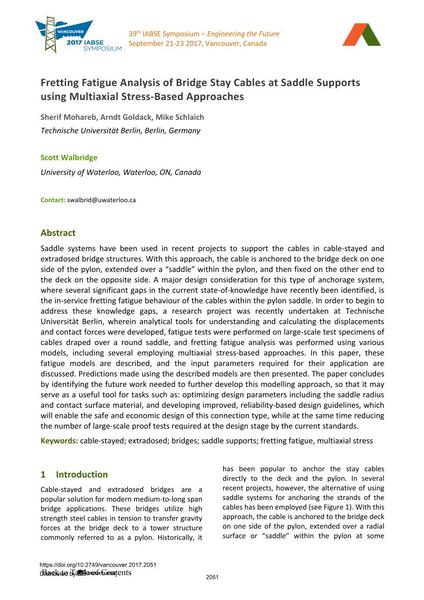Fretting Fatigue Analysis of Bridge Stay Cables at Saddle Supports using Multiaxial Stress-Based Approaches

|
|
|||||||||||
Détails bibliographiques
| Auteur(s): |
Sherif Mohareb
(Technische Universität Berlin, Berlin, Germany)
Arndt Goldack Mike Schlaich (Technische Universität Berlin, Berlin, Germany) Scott Walbridge (University of Waterloo, Waterloo, ON, Canada) |
||||
|---|---|---|---|---|---|
| Médium: | papier de conférence | ||||
| Langue(s): | anglais | ||||
| Conférence: | IABSE Symposium: Engineering the Future, Vancouver, Canada, 21-23 September 2017 | ||||
| Publié dans: | IABSE Symposium Vancouver 2017 | ||||
|
|||||
| Page(s): | 2051-2058 | ||||
| Nombre total de pages (du PDF): | 8 | ||||
| Année: | 2017 | ||||
| DOI: | 10.2749/vancouver.2017.2051 | ||||
| Abstrait: |
Saddle systems have been used in recent projects to support the cables in cable-stayed and extradosed bridge structures. With this approach, the cable is anchored to the bridge deck on one side of the pylon, extended over a “saddle” within the pylon, and then fixed on the other end to the deck on the opposite side. A major design consideration for this type of anchorage system, where several significant gaps in the current state-of-knowledge have recently been identified, is the in-service fretting fatigue behaviour of the cables within the pylon saddle. In order to begin to address these knowledge gaps, a research project was recently undertaken at Technische Universität Berlin, wherein analytical tools for understanding and calculating the displacements and contact forces were developed, fatigue tests were performed on large-scale test specimens of cables draped over a round saddle, and fretting fatigue analysis was performed using various models, including several employing multiaxial stress-based approaches. In this paper, these fatigue models are described, and the input parameters required for their application are discussed. Predictions made using the described models are then presented. The paper concludes by identifying the future work needed to further develop this modelling approach, so that it may serve as a useful tool for tasks such as: optimizing design parameters including the saddle radius and contact surface material, and developing improved, reliability-based design guidelines, which will enable the safe and economic design of this connection type, while at the same time reducing the number of large-scale proof tests required at the design stage by the current standards. |
||||
| Mots-clé: |
ponts extradossé
|
||||
